The iPhone 5s Review
by Anand Lal Shimpi on September 17, 2013 9:01 PM EST- Posted in
- Smartphones
- Apple
- Mobile
- iPhone
- iPhone 5S
iPhone Performance Across Generations
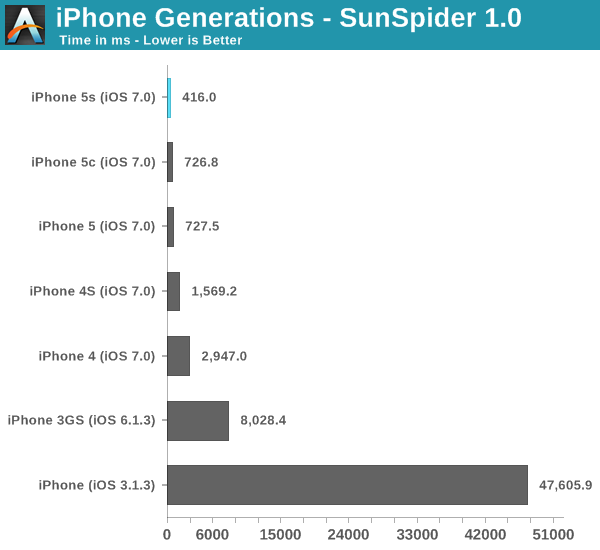
Performance improved by a factor of 100x compared to the original iPhone. You can cut that in half if the iPhone could run iOS 4. Needless to say, Apple's CPU performance estimates aren't unreasonable. We've come a long way since the days when ARM11 cores were good enough.
Even compared to a relatively modern phone like the iPhone 4, the jump to a 5s is huge. The gap isn't quite at the level of an order of magnitude, but it's quickly approaching it. Using the single core iPhone 4 under iOS 7 just feels incredibly slow. Starting with the 4S things get a lot better, but I'd say the iPhone 4 is at the point now where it's starting to feel too slow even for normal consumers (at least with iOS 7 installed).
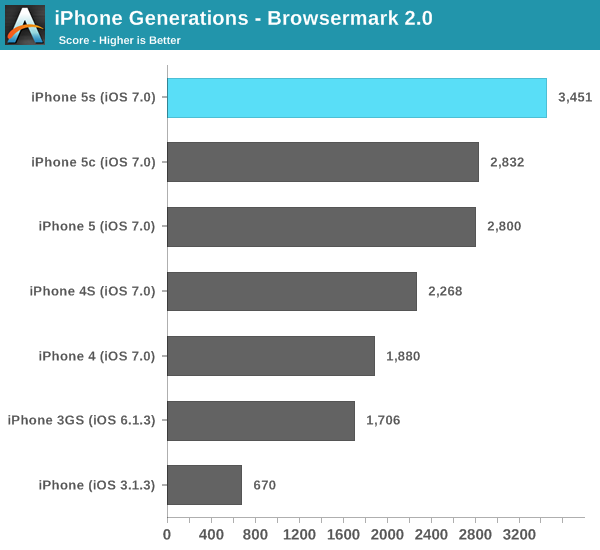
Browsermark 2.0 gives us a good indication of less CPU bound performance gains. Here we see over a 5x increase in performance compared to the original iPhone, and an 83% increase compared to the iPhone 4.
I wanted to have a closer look at raw CPU performance so I turned to Geekbench 3. Unfortunately Geekbench 3 won't run on anything older than iOS 6, so the original iPhone bows out of this test.
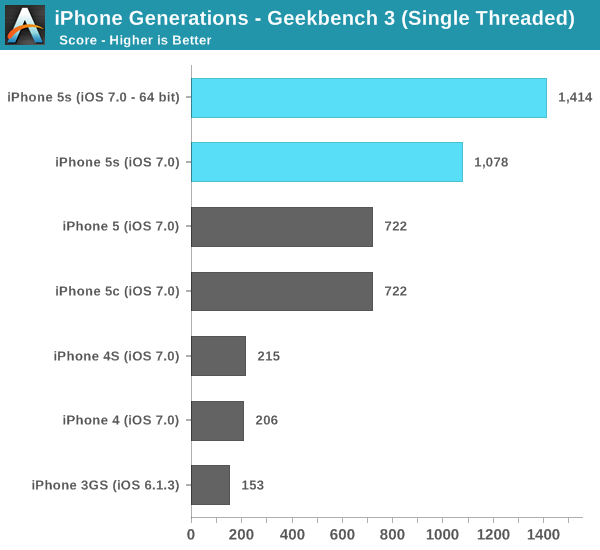
Single threaded performance scaled by roughly 9x from the 3GS to the iPhone 5s. The improvement since the iPhone 4/4S days is around 6.5x. Single threaded performance often influences snappiness and UI speed/feel, so it's definitely an important vector to scale across.
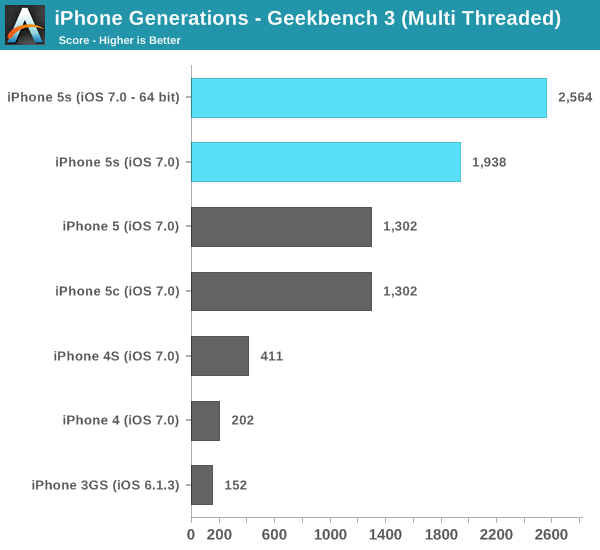
Take into account multithreaded performance and the increase over the 3GS is even bigger, almost 17x now.
The only 3D test I could get to reliably run across all of the platforms (outside the original iPhone) was Basemark X. Again I had issues getting Basemark X running in offscreen mode on iOS 7 so all of the tests here are run at each device's native resolution. In the case of the 3GS to 4 transition, that means a performance regression as the 3GS had a much lower display resolution to deal with.
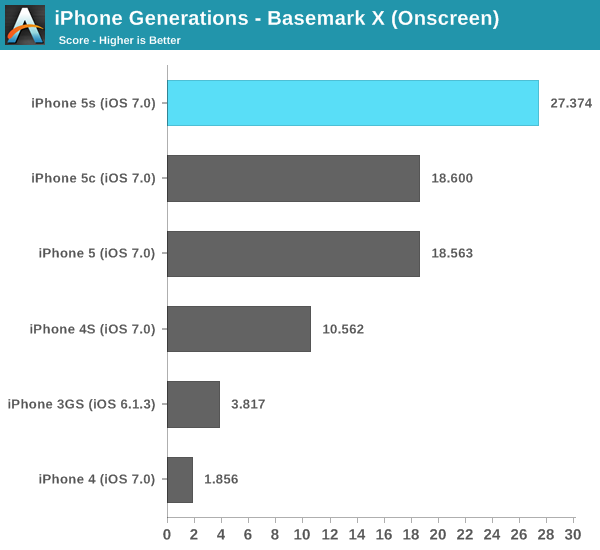
Apple has scaled GPU performance pretty much in line with CPU performance over the years. The 5s scores 15x the frame rate of the iPhone 4, at a higher resolution too.
iPhone 5s vs. Bay Trail
I couldn't help but run Intel's current favorite mobile benchmark on the iPhone 5s. WebXPRT by Principled Technologies is a collection of browser based benchmarks that use HTML5 and js to simulate a number of workloads (photo editing, face detection, stocks dashboard and offline notes).
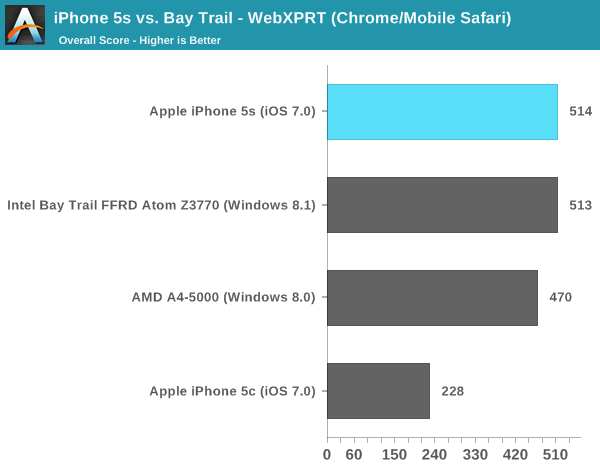
Granted we're comparing across platforms/browsers here, but the 5s as a platform does extremely well in Intel's favorite benchmark. The 5c by comparison performs a lot more like what we'd expect from a smartphone platform. The iPhone 5s is in a league of its own here. While I don't expect performance equalling the Atom Z3770 across the board, the fact that Apple is getting this close (with two fewer cores at that) is a testament to the work done in Cupertino.
At its launch event Apple claimed the A7 offered desktop class CPU performance. If it really is performance competitive with Bay Trail, I think that statement is a fair one to make. We're not talking about Haswell or even Ivy Bridge levels of desktop performance, but rather something close to mobile Core 2 Duo class. I've broken down the subtests in the table below:
| WebXPRT Performance (time in ms, lower is better) | ||||||
| Chrome/Mobile Safari | Photo Effects | Face Detection | Stocks | Offline Notes | ||
| Apple iPhone 5s (Apple A7 1.3GHz) | 878.9 ms | 1831.4 ms | 436.1 ms | 604.6 ms | ||
| Intel Bay Trail FFRD (Atom Z3770 1.46GHz) | 693.5 ms | 1557.0 ms | 542.9 ms | 737.3 ms | ||
| AMD A4-5000 (1.5GHz) | 411.2 ms | 2349.5 ms | 719.1 ms | 880.7 ms | ||
| Apple iPhone 5c (Apple A6 1.3GHz) | 1987.6 ms | 4119.6 ms | 763.6 ms | 1747.6 ms | ||
It's not a clean sweep for the iPhone 5s, but keep in mind that we are comparing to the best AMD and Intel have to offer in this space. I suspect part of why this is close is because both of those companies have been holding back a bit (there's no rush to build the fastest low margin parts), but it doesn't change reality.










464 Comments
View All Comments
solipsism - Wednesday, September 18, 2013 - link
I hadn't seen such a concise explanation of this tech. Thanks.Dug - Wednesday, September 18, 2013 - link
Very interesting and strange no one else has thought of doing this. I know using Nikon's system (CLS) exposure seems to be always right on, but depending on white balance setting it always needs adjustment.zshift - Tuesday, September 17, 2013 - link
Awesome review! A great read, as always.Dman23 - Tuesday, September 17, 2013 - link
Another awesome review by Anand Lal Shimpi! Informative and on point... love it.Crono - Tuesday, September 17, 2013 - link
I want to point out for the sake of consistency that Apple's naming convention is to use lowercase letters after the number for the iPhones. So it's "4s", not "4S", at least according to their website. It's annoying, I know, just pointing it out because it confused me at first so I looked it up.dylan522p - Tuesday, September 17, 2013 - link
Yeah, Brian went on a twitter rant of sorts about it. Pretty small but annoying change.tipoo - Tuesday, September 17, 2013 - link
Am I wrong, or is this the highest IPC smartphone core out there? 1.3 GHz, dual core, and it still doubles the performance of the A6 landing it into the territory most phones take higher clocked quads to get into.doobydoo - Wednesday, September 18, 2013 - link
Landing it way beyond all the current quad core phones.UpSpin - Wednesday, September 18, 2013 - link
Browserbenchmarks != CPU performanceSo it's possible that the good Browser benchmarks result more in a better optimized JS engine built for the A7? (because Samsung, NVidia, MS, ATI, Intel, ... all cheat in benchmarks, it's even possible that Apple still uses the not further optimized JS and Browser engine for the 5C, to increase the gap between A6 and A7 and make people believe the better browser scores are because of the A7, instead it's just heavy software optimization?)
Isn't it odd that a RAW CPU benchmark (3D Mark unlimited - Physics) positions the iPhone 5S on the same step as 5C and 5? (assuming there is no bug). 3D Mark also probably doesn't take advantage of 64-bit, but so will no near future App either, especially, because of the limited RAM, Games won't take 64-bit in the future either, else they'll blow the RAM limit more easily.
ScienceNOW - Tuesday, September 17, 2013 - link
F'ing thing sucks! I can all write it and we do it live! we do it live!